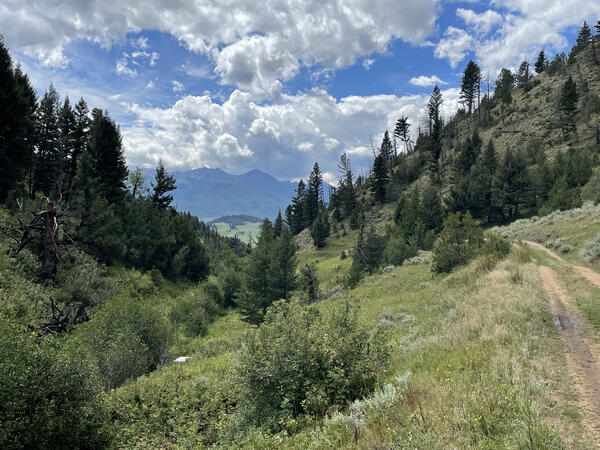Bison waiting by field technician's truck after a sample collection in Montana.
Lisa McKeon (Former Employee)
Science and Products
READI-Net—Providing tools for the early detection and management of aquatic invasive species READI-Net—Providing tools for the early detection and management of aquatic invasive species
U.S. Geological Survey Benchmark Glacier Project U.S. Geological Survey Benchmark Glacier Project
Modeling and measuring snow for assessing climate change impacts in Glacier National Park, Montana Modeling and measuring snow for assessing climate change impacts in Glacier National Park, Montana
An elevational gradient in snowpack chemical loading at Glacier National Park, Montana: implications for ecosystem processes An elevational gradient in snowpack chemical loading at Glacier National Park, Montana: implications for ecosystem processes
Grinnell Glacier 1938-2019
Jackson Glacier 1941-2019
Kintla Glacier 1901-2019
Grinnell Glacier from Mount Gould, 1938 - 1981 - 1998 - 2015
Grinnell Ridge, Gem & Salamander Glaciers 1910 - 2017
Grinnell Glacier 1938 - 2016
Grinnell Glacier 1911 - 2016
Grinnell Glacier, circa 1888-2016
Time Series of Glacier Retreat
Climate Change in Mountain Ecosystems (CCME)
Vegetation - Hidden Lake (b)
Vegetation - Sperry Glacier
Scanned field notebooks from a USGS Benchmark Glacier: South Cascade Glacier, Washington,1957 - 2022 Scanned field notebooks from a USGS Benchmark Glacier: South Cascade Glacier, Washington,1957 - 2022
A comprehensive inventory of maximum glacial extent in Glacier National Park during the peak of the Little Ice Age A comprehensive inventory of maximum glacial extent in Glacier National Park during the peak of the Little Ice Age
Geodetic Data for USGS Glaciers: Orthophotos, Digital Elevation Models, Glacier Boundaries and Surveyed Positions Geodetic Data for USGS Glaciers: Orthophotos, Digital Elevation Models, Glacier Boundaries and Surveyed Positions
Glaciers of Glacier National Park Repeat Photography Collection Glaciers of Glacier National Park Repeat Photography Collection
Glacier margin time series (1966, 1998, 2005, 2015) of the named glaciers of Glacier National Park, MT, USA Glacier margin time series (1966, 1998, 2005, 2015) of the named glaciers of Glacier National Park, MT, USA
Bison waiting by field technician's truck after a sample collection in Montana.
A filter from the Smith-Root sampler that collects eDNA when water is pushed through. This pattern is indicative of turbid water passing through the filter.
A filter from the Smith-Root sampler that collects eDNA when water is pushed through. This pattern is indicative of turbid water passing through the filter.

Robotic sampler deployed streamside at Flying D Ranch
Robotic sampler deployed streamside at Flying D RanchAn autonomous sampler (white box) is visible alongside a stream site in Montana
Robotic sampler deployed streamside at Flying D Ranch
Robotic sampler deployed streamside at Flying D RanchAn autonomous sampler (white box) is visible alongside a stream site in Montana
USGS scientist shoots a repeat photograph of Grinnell Glacier in Glacier National Park to illustrate glacial recession due to impacts of climate change.
USGS scientist shoots a repeat photograph of Grinnell Glacier in Glacier National Park to illustrate glacial recession due to impacts of climate change.
The Glacier - Climate Connection The Glacier - Climate Connection
Science and Products
READI-Net—Providing tools for the early detection and management of aquatic invasive species READI-Net—Providing tools for the early detection and management of aquatic invasive species
U.S. Geological Survey Benchmark Glacier Project U.S. Geological Survey Benchmark Glacier Project
Modeling and measuring snow for assessing climate change impacts in Glacier National Park, Montana Modeling and measuring snow for assessing climate change impacts in Glacier National Park, Montana
An elevational gradient in snowpack chemical loading at Glacier National Park, Montana: implications for ecosystem processes An elevational gradient in snowpack chemical loading at Glacier National Park, Montana: implications for ecosystem processes
Grinnell Glacier 1938-2019
Jackson Glacier 1941-2019
Kintla Glacier 1901-2019
Grinnell Glacier from Mount Gould, 1938 - 1981 - 1998 - 2015
Grinnell Ridge, Gem & Salamander Glaciers 1910 - 2017
Grinnell Glacier 1938 - 2016
Grinnell Glacier 1911 - 2016
Grinnell Glacier, circa 1888-2016
Time Series of Glacier Retreat
Climate Change in Mountain Ecosystems (CCME)
Vegetation - Hidden Lake (b)
Vegetation - Sperry Glacier
Scanned field notebooks from a USGS Benchmark Glacier: South Cascade Glacier, Washington,1957 - 2022 Scanned field notebooks from a USGS Benchmark Glacier: South Cascade Glacier, Washington,1957 - 2022
A comprehensive inventory of maximum glacial extent in Glacier National Park during the peak of the Little Ice Age A comprehensive inventory of maximum glacial extent in Glacier National Park during the peak of the Little Ice Age
Geodetic Data for USGS Glaciers: Orthophotos, Digital Elevation Models, Glacier Boundaries and Surveyed Positions Geodetic Data for USGS Glaciers: Orthophotos, Digital Elevation Models, Glacier Boundaries and Surveyed Positions
Glaciers of Glacier National Park Repeat Photography Collection Glaciers of Glacier National Park Repeat Photography Collection
Glacier margin time series (1966, 1998, 2005, 2015) of the named glaciers of Glacier National Park, MT, USA Glacier margin time series (1966, 1998, 2005, 2015) of the named glaciers of Glacier National Park, MT, USA
Bison waiting by field technician's truck after a sample collection in Montana.
Bison waiting by field technician's truck after a sample collection in Montana.
A filter from the Smith-Root sampler that collects eDNA when water is pushed through. This pattern is indicative of turbid water passing through the filter.
A filter from the Smith-Root sampler that collects eDNA when water is pushed through. This pattern is indicative of turbid water passing through the filter.

Robotic sampler deployed streamside at Flying D Ranch
Robotic sampler deployed streamside at Flying D RanchAn autonomous sampler (white box) is visible alongside a stream site in Montana
Robotic sampler deployed streamside at Flying D Ranch
Robotic sampler deployed streamside at Flying D RanchAn autonomous sampler (white box) is visible alongside a stream site in Montana
USGS scientist shoots a repeat photograph of Grinnell Glacier in Glacier National Park to illustrate glacial recession due to impacts of climate change.
USGS scientist shoots a repeat photograph of Grinnell Glacier in Glacier National Park to illustrate glacial recession due to impacts of climate change.
















